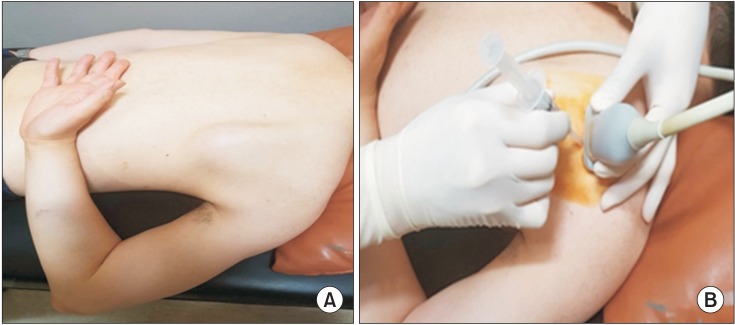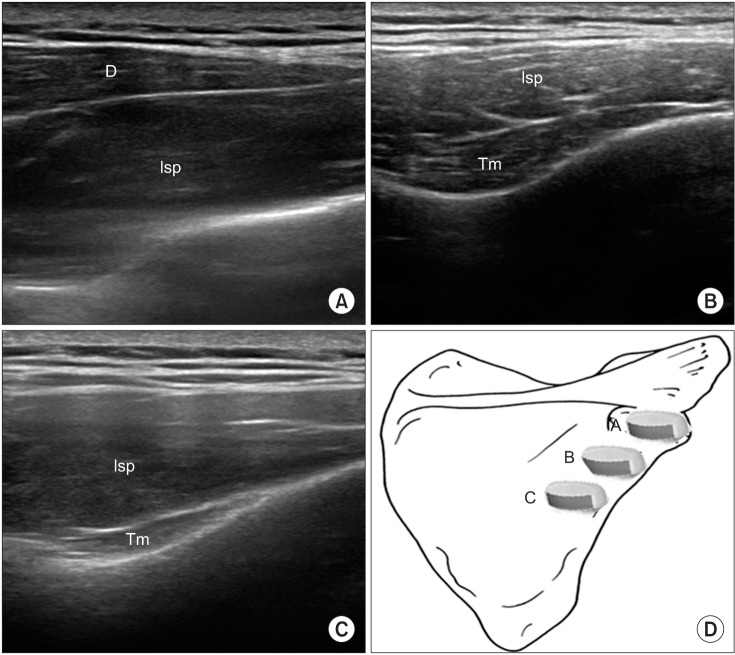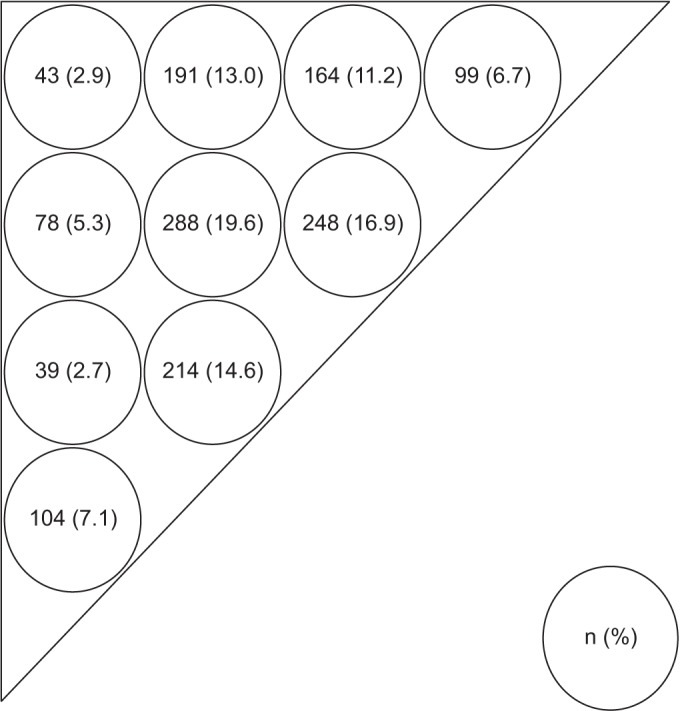Ann Rehabil Med.
2017 Aug;41(4):573-581. 10.5535/arm.2017.41.4.573.
Characteristics of Myofascial Pain Syndrome of the Infraspinatus Muscle
- Affiliations
-
- 1Department of Rehabilitation Medicine and Research Institute of Rehabilitation Medicine, Yonsei University College of Medicine & Severance Hospital, Seoul, Korea. bettertomo@yuhs.ac
- 2Department of Physical Medicine and Rehabilitation, National Health Insurance Service Ilsan Hospital, Goyang, Korea.
- 3Department of Physical and Rehabilitation Medicine, Samsung Medical Center, Sungkyunkwan University School of Medicine, Seoul, Korea.
- KMID: 2389402
- DOI: http://doi.org/10.5535/arm.2017.41.4.573
Abstract
OBJECTIVE
To report the characteristics of myofascial trigger points (MTrPs) in the infraspinatus muscle and evaluate the therapeutic effect of trigger-point injections.
METHODS
Medical records of 297 patients (221 women; age, 53.9±11.3 years) with MTrPs in the infraspinatus muscle were reviewed retrospectively. Because there were 83 patients with MTrPs in both infraspinatus muscles, the characteristics of total 380 infraspinatus muscles with MTrPs (214 one side, 83 both sides) were investigated. Specific characteristics collected included chief complaint area, referred pain pattern, the number of local twitch responses, and distribution of MTrPs in the muscle. For statistical analysis, the paired t-test was used to compare a visual analogue scale (VAS) before and 2 weeks after the first injection.
RESULTS
The most common chief complaint area of MTrPs in the infraspinatus muscle was the scapular area. The most common pattern of referred pain was the anterolateral aspect of the arm (above the elbow). Active MTrPs were multiple rather than single in the infraspinatus muscle. MTrPs were frequently in the center of the muscle. Trigger-point injection of the infraspinatus muscle significantly decreased the pain intensity. Mean VAS score decreased significantly after the first injection compared to the baseline (7.11 vs. 3.74; p<0.001).
CONCLUSION
Characteristics of MTrPs and the therapeutic effects of trigger-point injections of the infraspinatus muscle were assessed. These findings could provide clinicians with useful information in diagnosing and treating myofascial pain syndrome of the infraspinatus muscle.
MeSH Terms
Figure
Reference
-
1. Hong CZ. Pathophysiology of myofascial trigger point. J Formos Med Assoc. 1996; 95:93–104. PMID: 9064014.2. Hong CZ, Simons DG. Pathophysiologic and electrophysiologic mechanisms of myofascial trigger points. Arch Phys Med Rehabil. 1998; 79:863–872. PMID: 9685106.
Article3. Hong CZ. Myofascial pain therapy. J Musculoskelet Pain. 2004; 12:37–43.
Article4. Zhang Y, Ge HY, Yue SW, Kimura Y, Arendt-Nielsen L. Attenuated skin blood flow response to nociceptive stimulation of latent myofascial trigger points. Arch Phys Med Rehabil. 2009; 90:325–332. PMID: 19236988.
Article5. Ge HY, Fernandez-de-las-Penas C, Arendt-Nielsen L. Sympathetic facilitation of hyperalgesia evoked from myofascial tender and trigger points in patients with unilateral shoulder pain. Clin Neurophysiol. 2006; 117:1545–1550. PMID: 16737848.
Article6. Kimura Y, Ge HY, Zhang Y, Kimura M, Sumikura H, Arendt-Nielsen L. Evaluation of sympathetic vasoconstrictor response following nociceptive stimulation of latent myofascial trigger points in humans. Acta Physiol (Oxf). 2009; 196:411–417. PMID: 19210492.
Article7. Mochizuki T, Sugaya H, Uomizu M, Maeda K, Matsuki K, Sekiya I, et al. Humeral insertion of the supraspinatus and infraspinatus: new anatomical findings regarding the footprint of the rotator cuff: surgical technique. J Bone Joint Surg Am. 2009; 91(Suppl 2 Pt 1):1–7.8. Sola AE, Kuitert JH. Myofascial trigger point pain in the neck and shoulder girdle: report of 100 cases treated by injection of normal saline. Northwest Med. 1955; 54:980–984. PMID: 13253967.9. Pace JB. Commonly overlooked pain syndromes responsive to simple therapy. Postgrad Med. 1975; 58:107–113.
Article10. Sola AE, Rodenberger ML, Gettys BB. Incidence of hypersensitive areas in posterior shoulder muscles: a survey of two hundred young adults. Am J Phys Med. 1955; 34:585–590. PMID: 13268620.11. Travell J, Simons D, Simons L. Myofascial pain and dysfunction: the trigger point manual (Vol. 2: The lower extremities). Baltimore: Williams & Wilkins;1999.12. Rha DW, Shin JC, Kim YK, Jung JH, Kim YU, Lee SC. Detecting local twitch responses of myofascial trigger points in the lower-back muscles using ultrasonography. Arch Phys Med Rehabil. 2011; 92:1576–1580. PMID: 21839982.
Article13. Kim DS, Jeong TY, Kim YK, Chang WH, Yoon JG, Lee SC. Usefulness of a myofascial trigger point injection for groin pain in patients with chronic prostatitis/chronic pelvic pain syndrome: a pilot study. Arch Phys Med Rehabil. 2013; 94:930–936. PMID: 23262156.
Article14. Suh MR, Chang WH, Choi HS, Lee SC. Ultrasound-guided myofascial trigger point injection into brachialis muscle for rotator cuff disease patients with upper arm pain: a pilot study. Ann Rehabil Med. 2014; 38:673–681. PMID: 25379497.
Article15. Rubin D. Myofascial trigger point syndromes: an approach to management. Arch Phys Med Rehabil. 1981; 62:107–110. PMID: 6453568.16. Sola AE, Williams RL. Myofascial pain syndromes. Neurology. 1956; 6:91–95. PMID: 13288760.
Article17. Travell J, Rinzler SH. Pain syndromes of the chest muscles; resemblance to effort angina and myocardial infarction, and relief by local block. Can Med Assoc J. 1948; 59:333–338. PMID: 18886698.18. Travell J, Rinzler SH. The myofascial genesis of pain. Postgrad Med. 1952; 11:425–434. PMID: 14920327.
Article19. Muscolino JE. The muscle and bone palpation manual with trigger points, referral patterns and stretching. St. Louis: Elsevier/Mosby;2009.20. Ombregt L. A system of orthopaedic medicine. Edinburgh: Churchill Livingstone;2013.21. Kelly M. Some rules for the employment of local analgesia in the treatment of somatic pain. Med J Aust. 1947; 1:235–239. PMID: 20291539.
Article22. Long C. Myofascial pain syndromes. II. Syndromes of the head, neck and shoulder girdle. Henry Ford Hosp Med Bull. 1956; 4:22–28. PMID: 13318636.23. Reynolds MD. Myofascial trigger point syndromes in the practice of rheumatology. Arch Phys Med Rehabil. 1981; 62:111–114. PMID: 7235894.24. Criscuolo CM. Interventional approaches to the management of myofascial pain syndrome. Curr Pain Headache Rep. 2001; 5:407–411. PMID: 11560805.
Article25. Rivner MH. The neurophysiology of myofascial pain syndrome. Curr Pain Headache Rep. 2001; 5:432–440. PMID: 11560808.
Article26. Hong CZ. Lidocaine injection versus dry needling to myofascial trigger point: the importance of the local twitch response. Am J Phys Med Rehabil. 1994; 73:256–263. PMID: 8043247.27. Simons DG. Review of enigmatic MTrPs as a common cause of enigmatic musculoskeletal pain and dysfunction. J Electromyogr Kinesiol. 2004; 14:95–107. PMID: 14759755.
Article28. Zhuang X, Tan S, Huang Q. Understanding of myofascial trigger points. Chin Med J (Engl). 2014; 127:4271–4277. PMID: 25533832.29. Ito N. Electromyographic study of shoulder joint. Nihon Seikeigeka Gakkai Zasshi. 1980; 54:1529–1540. PMID: 7229462.30. Lucas KR, Polus BI, Rich PA. Latent myofascial trigger points: their effects on muscle activation and movement efficiency. J Bodyw Mov Ther. 2004; 8:160–166.
Article
- Full Text Links
- Actions
-
Cited
- CITED
-
- Close
- Share
- Similar articles
-
- Botulinum Toxin-Type A in Cervical Myofascial Pain Syndrome: A report of 3 cases
- Thoracic Kyphosis and Myofascial Pain Syndrome in Male Adolescents
- Changes in the Pressure Threshold of Myofascial Trigger Points Following Freezing Cold Air Application
- Treatment Experience of Pulsed Radiofrequency Under Ultrasound Guided to the Trapezius Muscle at Myofascial Pain Syndrome: A Case Report
- Pain Patterns of Experimental Muscle Pain Using Hypertonic Saline




